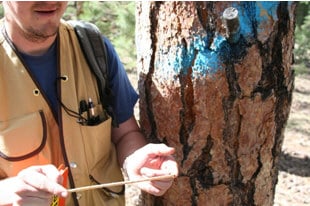Just in time for the “Forest Jobs Tour ” (a series of one-sided presentations around Montana about Senator Tester’s mandated logging bill, the Forest Jobs and Recreation Act) “timber partners” RY Timber, Pyramid Mountain Lumber, Roseburg Forest Products and Sun Mountain Lumber took out this full-page advertisement today in at least six Montana newspapers, including the Helena Independent Record, Missoulian, Kalispell Daily Interlake, Great Falls Tribune, Montana Standard and Bozeman Chronicle According to Ad reps I spoke with at two of the papers, the retail cost of the advertisements likely ran between $27,000 and $31,000.
The title of the Ad is “Out of Control Administrative Appeals and Frivolous Lawsuits Against the U.S. Forest Service Must be Stopped Now!!!”
The full-page timber industry Ad is full of statements such as this: “We believe the Forest Service is being held hostage by a small group of professional obstructionists.” The Ad ends with these timber mills providing the following “solutions,” including suggesting that Congress could simply exempt many timber sales from judicial review, just as was done with the Wolf Rider from Senator Tester. [note: all emphasis is as it appeared in the Ad]
“We see several options available to Congress to immediately rectify these abuses:
1) Amend the Equal Access to Justice Act by requiring a Cash Bond in these types of administrative appeals and lawsuits. Amend the Act further by implementing a Loser Pay System, where the loser is responsible for paying the attorneys’ fees and costs of the overall prevailing party.
2) In designated Timber Management Areas already established under the approved Forest Plans, Congress could exempt from judicial review those Timber Sales which deal with trees that have been killed or severely damaged by the Mountain Pine Beetle. The authority of Congress to limit court jurisdiction can be found under Article III Section 2 of United States Constitution. A similar limitation was recently enacted by Congress when they removed Gray Wolf from the Endangered Species List and barred the federal court from any further review.
3) Scrap the entire Forest Service Administrative Appeals Process and use the more streamlined approach that the Department of Interior – BLM uses for their timber projects.”
More about the timing of these Ads. It must be pointed out that these same exact timber mills are sharing the stage this week and next week with their friends – or is the correct term ‘collaborators’ – representing the Montana Wilderness Association, National Wildlife Federation, Montana Trout Unlimited and the Greater Yellowstone Coalition for the Forest Jobs Tour to support Senator Tester’s mandated logging bill, S. 268. So, the timing of the timber industry’s $30,000 Ad ‘Blitzkrieg’ couldn’t be more transparent.
Honestly, having already attended a number of these one-sided FJRA dog-n-pony shows I doubt I’ll waste my time – and a perfectly good spring evening – attending any of the ‘Forest Jobs Tour.’ In the past, these events have been carefully scripted to limit any tough, substantive questions or dissent and I assume that tonight’s Tour stop in Missoula will be the same. Heck, during a similar FJRA event – held in a public building at the University of Montana – a representative of Montana Wilderness Association even attempted to prevent one of our interns from passing out simple handbills announcing a “Forest Jobs and Recreation Act Study Club,” the sole purpose of which was to simply read the actual bill language, and then discuss what the language means.
However, I can’t help but wonder if during this so-called “Forest Jobs Tour” if these conservation groups will bother to express concern or speak out against their “timber partners'” wish list for more logging, less public and scientific over-sight and no judicial review of Forest Service timber sales? Or will these conservation groups give their consent through their public silence? I have a hunch I know how the “collaborators” will roll. And, if that hunch is correct, what does that truly say about the state of their collaboration with the timber industry?
Update: People may be interested to know that Montana Trout Unlimited and Pew’s Campaign for America’s Wilderness have deleted the following comments I made on their Facebook pages (here and here) and have blocked me from commenting ever again in the future. This tactic has also been recently used by Montana Wilderness Association (here and here) and Hellgate Hunters and Anglers, which is part of the National Wildlife Federation. In fact, Hellgate Hunters and Anglers (a group I was once a member of) censored and removed my substantive comments regarding the FJRA, including the actual official testimony of the head of the Forest Service from their ironically named “Bully Pulpit” blog. This has been a very common tactic used by the “collaborator” conservation groups supporting the FJRA and I believe the public should be aware of this tactic.


